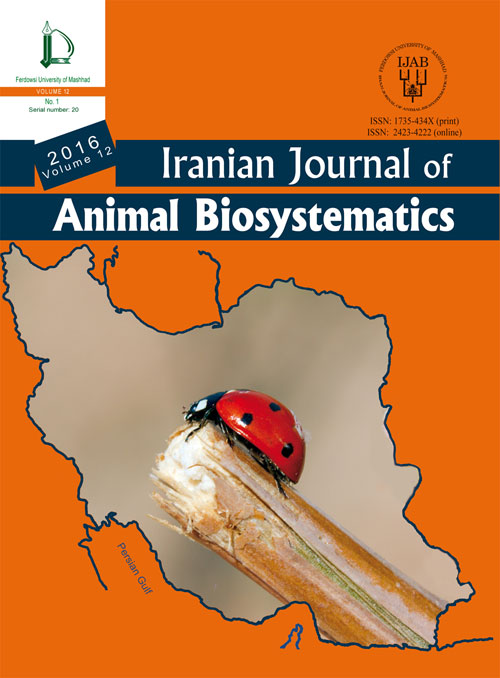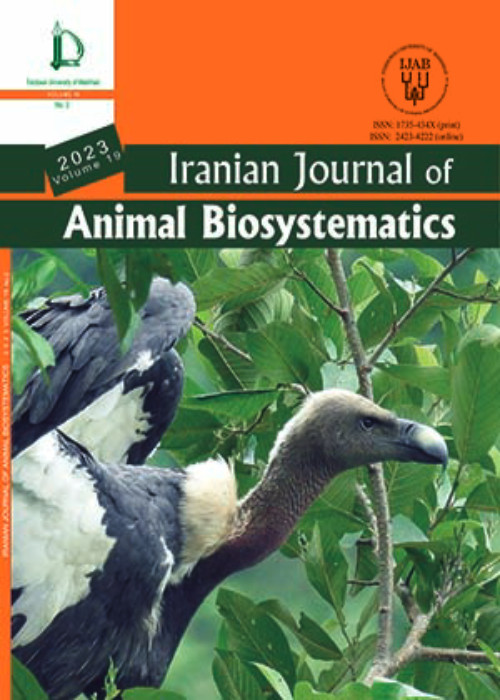فهرست مطالب

Iranian journal of animal biosystematics
Volume:12 Issue: 2, Summer-Autumn 2016
- تاریخ انتشار: 1395/10/11
- تعداد عناوین: 11
-
-
Page 145We present the results of a survey of the andrenid bee fauna of Gorgan County, Golestan province, Iran between 2014 and 2015. The survey led to the identification of twenty-three species of the genus Andrena Fabricius and Melitturga Latreille belonging to subgenera Campylogaster (1 species), Chlorandrena (1 species), Holandrena (2 species), Hoplandrena (1 species), Melanapis (1 species), Melandrena (4 species), Micrandrena (4 species), Nobandrena (1 species), Notandrena (1 species), Plastandrena (2 species), Simandrena (1 species), Truncandrena (1 species), Zonandrena (2) and Melitturga (1 species). Of these, eight and six species are new to the fauna of Iran and Asia, respectively.Keywords: Andrenidae, Gorgan County, Iran, new record
-
Page 157The results of faunistic survey of jewel beetles (Coleoptera: Buprestidae) carried out in Kurdistan Province of Iran are presented. 30 species belonging to two subfamilies (Buprestinae and Agrilinae) and 8 genera were collected. Of these 1 species is new for Iranian fauna and 19 species are new for Kurdistan Province.Keywords: Coleoptera, Buprestidae, Iran, Kurdistan, fauna, new records
-
Page 167The first comprehensive catalogue of leaf beetles (subfamily Galerucinae s. str.) from Iran is reviewed and several field trips were conducted from 2012 to 2015. In total, 44 species belonging to 18 genera of three tribes (Galerucini, Hylaspini and Luperini) are listed. Iranian Galerucinae is characterized by 11 endemic species. For every species provincial distributions is given based on available literature records and additional province records were examined. All species that deposited in Jalal Afshar Zoological Museum (University of Tehran) are reported. Moreover, Luperus perlucidus Iablokoff-Khnzorian, 1956 is reported as a new record for Iranian Chrysomelidae. Theone octocostata afghanistanica Mandl, 1968, Galerucella nymphaeae (Linnaeus, 1758), Galeruca pomonae (Scopoli, 1763), Exosoma thoracicum (Redtenbacher, 1843) and Luperus kiesenwetteri Joannis, 1865 which were omitted in the catalogue of Palaearctic Coleoptera added again to the leaf beetle fauna of Iran. In addition, 13 new records for the administrative provinces of Iran are provided.Keywords: Chrysomelidae, Galerucinae, Catalogue, New record, Iran
-
Page 181During a survey on the entomopathogenic nematodes from Kerman province of Iran, three new populations of Heterorhabditis bacteriophora were recovered from natural areas. Description, measurement and illustration are provided for these isolates. Molecular analysis on ITS sequence of new isolates of H. bacteriophora set these populations close to a population from South Africa (EU700310). H. bacteriophora and H. georgiana formed a monophyletic group. This is the first data of ITS rDNA of H. bacteriophora from south eastern Iran (Kerman province). Analysis of Iranian H. bacteriophora showed that Kerman isolates place close to Mashhad isolates.Keywords: Heterorhabditis, Iran, ITS rDNA, morphology, phylogeny, taxonomy
-
Page 191ThePurposeA survey was conducted to identify the hover flies in South-east Khorasan-e Razavi Province, Iran during 2011-2012. BasicMethodologyThese species were collected by sweeping net on flowers as pollinators. Main findings: Among of 231 collected specimens, 17 species belonging to 10 genera and two subfamilies were verified. All of them are recorded for the first time from khaf region. Eumerus ornatus (Meigen, 1822) is a new record for the fauna of Khorasan-e Razavi Province.Keywords: Khaf, Khorasan-e Razavi Province, Syrphidae
-
Page 203Hyalomma and Rhipicephalus (Acari: Ixodidae: Rhipicephalinae) are the most important ectoparasites and biological vector of pathogen agents. The taxonomy of some Hyalomma and Rhipicephalus species is more debatable. The traditional taxonomy of ticks have been revolutionized using polymerase chain reaction. The specificity, efficiency and accuracy of PCR is highly dependent on the oligonucleotide primers. In this study, five primers designed for amplification of a fragment ITS2 so-called TAH-1, TAH-2, TRH (for Hyalomma) and TAH-3, TAH-4 (for Rhipicephalus). Successfully, 24 and 29 ITS2 sample was sequenced using these primers. As well as, an ITS2 phylogenetic tree were constructed using BEAST basis on the Bayesian Inference (BI) method. The most Hyalomma and Rhipicephalus species well differentiated using ITS2 fragment since the designed primer fail to amplify gene target in few cases.Keywords: PCR, Primer, ITS2, Hyalomma, Rhipicephalus, Phylogenetic relationship
-
Page 211There are several papers related to the split of the Mabuya group (sensu lato) into four different subfamilies (Chinoniniinae, Mabuyinae, Dasiinae, Trachylepidinae). The Iranian species of Mabuya and totally the Middle East species of this old genus come under Afro-Malagasy clade. Also septemtaeniata and transcaucasica are more related to Euprepis branch in Afro-Malagasy clade. Further, transcaucasica should be treated as a subspecies of Euprepis and with septemtaeniata as a good species (Mausfeld and Schmitz, 2003). The Turkish species of Mabuya not only belong to any of the four aforementioned genera (Durmuş et al., 2011), but also diversified from Mabuya and the rest Trachylepis species (Güçlü et al., 2014). The Mabuya Afro-Malagasy and Cape Verdian group morphologically shows an intermediate position between the Asian and the South American groups. Assuming an Asian origin of the genus Mabuya (Horton 1973; Greer 1977) (Quoted from Faizi and Rastegar-Pouyani, 2006).
According to Moravec et al. (2006) there is no record of T.aurata from Iran, but Turkish populations belong to T.aurata. The Populations from central and northern Iran belong to T. s. transcaucasiaca (Čhernov, 1926) and southern populations belonging to Trachylepis septemtaeniata (Reuss, 1834). According to Morphological and molecular data, the Turkish T.vittata, T.aurata, T. septemtaeniata are separate species and T. vittata is branched off first. Based on morphological characters the Iranian T.vittata is a distinct species. The aim of this study is to provide a detailed account on current taxonomic and distributional status of the genus Trachylepis with special reference to the Iranian Plateau species. A new and updated taxonomic, biogeographic and phylogenetic status of the Iranian species of Trachylepis, based on morphological and molecular data, is at hand by the authorsKeywords: Systematics, Scincidae, Trachylepis, Iran -
Page 225There are several papers related to the split of the genus Eumeces sensu lato into four distinct genera (Eumeces sensu stricto Wiegmann, 1834; Plestiodon Duméril & Bibron, 1839; Mesoscincus Griffith, Ngo & Murphy, 2000 and Eurylepis Blyth, 1854). From these, three important ones stand out. The genus has undergone extensive taxonomic changes. There was an initial morphologcial split which identified the correct four groups but failed to get the correct nomenclatures. These errors were later corrected. In a chronological order, Novoeumeces suggested as a new name for the schneiderii group and subsequently re-changed to the genus Eumeces s.s. North American-clade is now considered as Plestiodon. The name Eumeces (sensu stricto) was retained for the group close to the type species (Eumeces pavimentatus) which is part of the African-Central Asian clade. There are now only five species of Eumeces left. The others (old Eumeces) are now found in Eurylepis (2 species), Mesoscincus (3 species) and Plestiodon (47 species). A detailed story of these changes plus a brief comparison of current four genera based on mentioned morphological characters in the literatures are discussed in this paper.Keywords: Systematics, Scincidae, Eumeces, Eurylepis, Novoeumeces, Iran
-
Page 239This study includes a check-list of semi-venomous and venomous snakes in Iraq along with their distribution and classification. Collectively, from the family Clubridae, three genera, and seven species of semi-venomous snakes and from the families Viperidae four genera and six species, Elapidae one genus and two species, Hydrophiinae five genera, and eight species of venomous snakes are distributed in different geographic regions of Iraq.Keywords: Checklist, Snakes, Semi-venomous, venomous, Distribution, Iraq
-
Page 249Attention is drawn to the overlooked occurrence of the Bridled skink in relatively northern provinces of central Turkey. Zoogeographical issues are discussed and ecological implications of living at high elevations are compared to those of lowland conditions. The apparent lack of uniform and bilineata colour pattern morphs, viz. the absence of polymorphism is indicated.Keywords: Trachylepis vittata, polymorphism, distribution, Turkey
-
Page 255The reptile's fauna of Sabzevar was investigated during 10 years (2003-2013). In total 43 species belonging to 29 genera, 13families and two orders (Squamata and Testudines) were collected and identified. The most diverse group in the area is lizards with 23 species, followed by snakes with 18 species and the testudines with one species. The most diverse families are Colubridae , Lacertidae with 8 and Gekkonidae with 5 species respectively, followed by Agamidae with 4 species, Viperidae, Boidae and Scincidae with 3 species each, Lamrophiidae and Spherodactylidae with 2 species and 4 families Elapidae, Thyphlopidae, Varanidae and Testudonidae with only one species eachKeywords: biodiversity, reptiles, Northeastern Iran, Sabzevar


